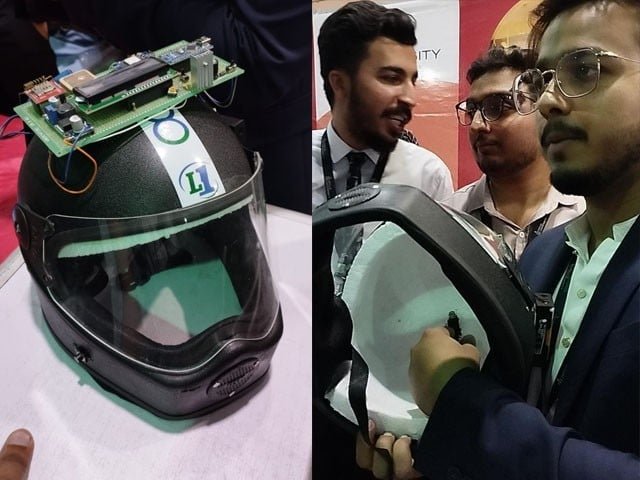The alert won’t be issued in the event of a helmet fall because pressure plates are installed inside the helmet, which are only activated when the helmet is worn.

The smart helmets are the result of the work of graduate students Mohammad Al-Tamish Akhtar and Mohammad Fahad from Indus University’s Department of Computer Science. They are outfitted with vibration sensors, GSM, and GPS systems, as well as a solar charging system.
Karachi computer engineers have created a smart helmet and accident alert system to protect motorbike riders from collisions and ensure prompt medical care in the event of an accident. The goal is to save the lives of motorcyclists in Karachi by providing immediate medical assistance.
The helmet sends out alerts to specific phone numbers, hospitals, ambulances, and wards, as well as the location of the motorbike rider wearing the helmet, to let friends and family know when there has been an accident or emergency.
A report published in the Pakistan General of Medical Science found that 87 percent of accidents in Karachi involve motorcyclists, of whom 43 percent are young people between the ages of 18 and 29. 15% of these accidents result in serious injuries, with 32 percent of riders sustaining a head injury, 64 percent a leg injury, and 37 percent a hand injury.
87% of motorcyclists who are victims of accidents do not wear helmets, indicating the dangers to their lives. The loss of life can be minimised by providing quick medical assistance in the event of an accident.
The invention by Altamish and Fahad also aims to save the lives of motorcycle riders. According to Muhammad Altmish Akhtar, the solar-powered smart helmet and emergency alert system are furnished with standard pressure plates, helmet-mounted sensors, and GPRS systems in addition to GSM.
The majority of the components in the initial sample are installed outside the helmet, whereas they will be installed inside the smart helmets in the final product to protect them from the effects of rain and wear and tear.
It is possible to provide immediate emergency medical assistance to the accident-prone motorcyclist by using the ambulance service’s vibration sensor system to alert friends and family to pre-specified emergency numbers of nearby hospitals. The location is also shared with the alert.
The alert won’t be issued in the event of a helmet fall because pressure plates are installed inside the helmet, which are only activated when the helmet is worn. However, motorcyclists can manually issue an alert in other emergency situations by pressing a button.
According to Mohammad Al-Tamish Akhtar, the price of this helmet, which was 10,000 rupees, will be coming down. Additional features, such as virtual head-off displays and machine learning, can also be added to the helmet.
With the help of virtualization on the helmet screen, the Virtual Head of Display facility will make it possible for maps and communication.
Delivery service Riders won’t have to keep turning their phones around in their hands because all communication and navigation will be visible on the windscreen of the helmet.
Adding more features will raise the price. Initial predictions indicate that the price of smart helmets with machine learning and virtual head-of-display features will double.
This helmet is a good business idea with a sizable market and a significant social impact, according to Altmish, and some investors have expressed interest in producing it commercially.
Manufacturers of bicycles can also profit from this market and use it to advance technology that will make the lives of their customers safer. He said that the next stage, which would require more resources, would focus on the helmet’s architecture.